Berchtesgaden
| Berchtesgaden | |
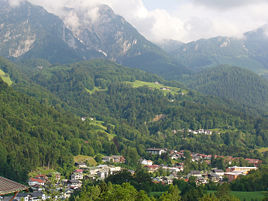 |
|
| Coat of arms | Location |
 |
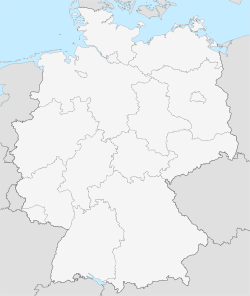 |
| Administration | |
| Country | Germany |
|---|---|
| State | Bavaria |
| Admin. region | Upper Bavaria |
| District | Berchtesgadener Land |
| Mayor | Rudolf Schaupp (FW) |
| Basic statistics | |
| Area | 34.78 km² (13.4 sq mi) |
| Elevation | 700 m (2297 ft) |
| Population | 7,752 (29/06/2004) |
| - Density | 223 /km² (577 /sq mi) |
| Other information | |
| Time zone | CET/CEST (UTC+1/+2) |
| Licence plate | BGL |
| Postal code | 83471 |
| Area codes | +49 8652 |
| Website | berchtesgaden.de |
| Location of Berchtesgaden within Berchtesgadener Land district | |
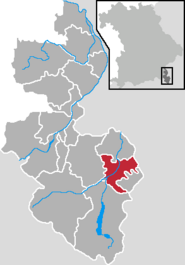 |
|
Berchtesgaden (IPA: [bɛʁçtəsˈgaːdən]) is a municipality in the German Bavarian Alps. It is located in the south district of Berchtesgadener Land in Bavaria, near the border with Austria, some 30 km south of Salzburg and 180 km southeast of Munich. It is situated north of the Nationalpark Berchtesgaden.
Berchtesgaden is often associated with the Mount Watzmann, at 2713 m the third-highest mountain in Germany (after Zugspitze and Hochwanner), which is renowned in the rock climbing community for its Ostwand] (East Face), and a deep glacial lake by the name of Königssee (5.2 km²). Another notable peak is the Kehlstein mountain (1835 m) with its Kehlsteinhaus (Eagle's Nest), which offers spectacular views to its visitors.
Berchtesgaden's neighboring towns are Bischofswiesen, Marktschellenberg, Ramsau, and Schönau am Königssee.
Contents |
History
First historical note dates back to 1102 and it mentions the area because of its rich salt deposits. Much of Berchtesgaden's wealth has been derived from its salt mines. The town served as independent Fürstpropstei until the Reichsdeputationshauptschluss in 1803. During the Napoleonic wars, Berchtesgaden changed hands a few times. Salzburg was always interested in Berchtesgaden and French troops occupied the area a short time. Berchtesgaden came under Bavarian rule in 1810 and became instantly popular with the Bavarian royal family, which often visited Königssee and maintained a royal hunting residence in the town itself. Nascent tourism started to evolve and a number of artists came to the area, which reportedly gave rise to "Malereck" (literally painter's corner) on the shore of Königssee. The most famous author who lived in Berchtesgaden was Ludwig Ganghofer.
Nazis in Berchtesgaden
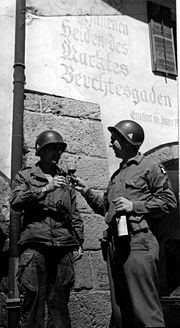
The area of Obersalzberg was purchased by the Nazis in the 1920s for their senior leaders to enjoy. Hitler's mountain residence, the Berghof, was located here. Berchtesgaden and its environs (Stanggass) were fitted to serve as an outpost of the German Reichskanzlei office (Imperial Chancellery), which sealed the area's fate as a strategic objective for Allied forces in World War II. Some typical Third Reich buildings in Berchtesgaden include the bahnhof (railway station), that had a reception for Hitler and his guests, and the postamt (post office) next to the bahnhof. The Berchtesgadener Hof Hotel was a hotel where famous visitors stayed, such as Eva Braun, Erwin Rommel, Josef Goebbels and Heinrich Himmler, as well as Neville Chamberlain in and David Lloyd George. The hotel was torn down in 2006. There is a museum on the spot now, called 'Haus der Berge'.
The Obersalzberg
A number of other relics of the Nazi era can still be found in the area, although only few of them are still well preserved. There is the Kehlsteinhaus (nicknamed Eagle's Nest by a French diplomat), which was built as a present for Hitler's 50th birthday in 1939. The remnants of homes of former Nazi leaders such as Adolf Hitler, Hermann Göring, and Martin Bormann were all demolished in the early post-war years.
The Platterhof was retained and served as a retreat for the American military. It was known as the General Walker Hotel. It was demolished in 2000. The only remaining buildings are the former SS HQ at Hotel Zum Türken and the Kehlsteinhaus. A small part of the Platterhof is also still there. The information centre on the mountain is the former guesthouse Höher Göll. It has an entrance to the Obersalzberg bunker system.
Post war era
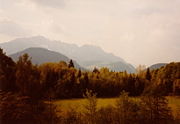
After the war, Obersalzberg became a military zone and most of its buildings were seized by the U.S. Army. Hotel Platterhof was rebuilt and renamed General Walker Hotel[1] in 1952. It served as an integral part of the U.S. Armed Forces Recreation Center (AFRC) for the duration of the Cold War and beyond. The Berghof was demolished in 1953.
In 1995, 50 years after the end of World War II and 5 years after German reunification, the AFRC Berchtesgaden was turned over to Bavarian authorities to facilitate military spending reductions mandated within the Base Realignment and Closure program by the United States Congress and the Pentagon during the administration of U.S. President Bill Clinton. The General Walker Hotel was demolished shortly thereafter. Its ruins, along with the remnants of the Berghof, were removed in 1996 to make room for a new bus depot serving the bus line to the Kehlsteinhaus and a for the new InterContinental Hotel Resort. The former guesthouse "Hoher Goell" now serves a new documentation center. It is the first German museum of its kind to chronicle the entire span of World War II in one spot.
Berchtesgaden today
In 1972, local government reform united the until then independent municipalities of Salzberg, Maria Gern and Au (consisting of Oberau and Unterau) under the administration of the town of Berchtesgaden. Another suggested reform uniting all remaining five municipalities in Berchtesgaden valley (Bischofswiesen, Ramsau, Markt Schellenberg and Schönau) failed to gain enough popular support; it passed in Berchtesgaden and failed everywhere else.
The Nationalpark Berchtesgaden was established in 1978 and has gradually become one of Berchtesgaden's largest draws. Luckily, mass tourism is confined to a few popular spots, which gives alternative, nature-seeking tourists more than enough space to find peace and quiet in the park. Major tourist draws are the Königssee, the salt mine (with a new sound and light show inaugurated in 2007), the Kehlsteinhaus and the new Dokumentationszentrum Obersalzberg.
Recreational and competitive sports have also grown in importance. Although Berchtesgaden's ski slopes are not among the largest in the Alps, they can easily accommodate everyone; from beginners to very competitive skiers and boarders. The Königssee bobsleigh, luge, and skeleton track has hosted ski-running and a number of international bobsleigh, luge, and skeleton events and competitions. Berchtesgaden's most famous sports personality is Georg Hackl, a multiple Olympic medal winner. The city is also home to the International Luge Federation (FIL).
Berchtesgaden has virtually no manufacturing industry, unlike the northern part of Berchtesgadener Land and the Salzburg area.
External links
- Municipal website (English)
- Municipal website (German)
- Regional website for visitors and tourists (German, English)
- Berchtesgaden National Park pictures and information
- PhotoGlobe - Berchtesgadener Land offers high quality photos of the area around Berchtesgaden together with GPS coordinates.
- AFRC Timeline
- "Third Reich in Ruins" (English - historical and modern comparison photos)
- Pictures from Berchtesgaden
- Map of Bavaria in 1789
- Pictures of Berchtesgaden taken in October 2006
|
|||||||